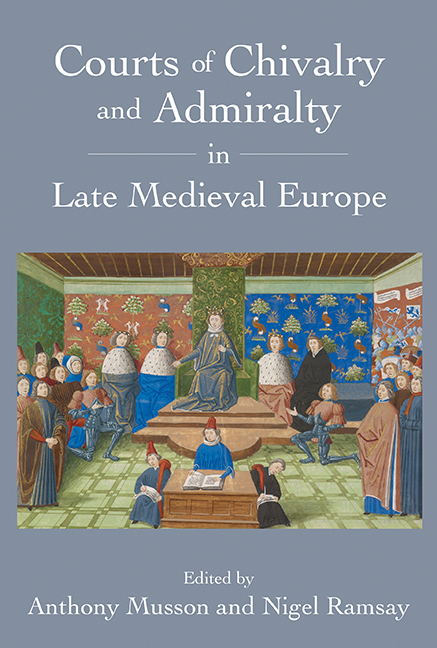Book contents
- Frontmatter
- Contents
- List of Illustrations
- Notes on Contributors
- Preface
- A Note on Editorial Practice
- List of Abbreviations
- Introduction
- Chapter 1 Heralds and the Court of Chivalry: From Collective Memory to Formal Institutions
- Chapter 2 French Armorial Disputes and Controls
- Chapter 3 Art, Objects and Ideas in the Records of the Medieval Court of Chivalry
- Chapter 4 Sir Robert Grosvenor and the Scrope–Grosvenor Controversy
- Chapter 5 From Brittany to the Black Sea: Nicholas Sabraham and English Military Experience in the Fourteenth Century
- Chapter 6 ‘Armed and redy to come to the felde’: Arming for the Judicial Duel in Fifteenth-Century England
- Chapter 7 The Jurisdiction of the Constable and Marshals of France in the Later Middle Ages
- Chapter 8 The Origins and Jurisdiction of the English Court of Admiralty in the Fourteenth Century
- Chapter 9 The Consulate of the Sea and its Fortunes in Late Medieval Mediterranean Countries
- Chapter 10 The Admiralty and Constableship of England in the Later Fifteenth Century: The Operation and Development of these Offices, 1462–85, under Richard, Duke of Gloucester and King of England
- Chapter 11 Some Dubious Beliefs about Medieval Prize Law
- index
Chapter 6 - ‘Armed and redy to come to the felde’: Arming for the Judicial Duel in Fifteenth-Century England
Published online by Cambridge University Press: 28 June 2018
- Frontmatter
- Contents
- List of Illustrations
- Notes on Contributors
- Preface
- A Note on Editorial Practice
- List of Abbreviations
- Introduction
- Chapter 1 Heralds and the Court of Chivalry: From Collective Memory to Formal Institutions
- Chapter 2 French Armorial Disputes and Controls
- Chapter 3 Art, Objects and Ideas in the Records of the Medieval Court of Chivalry
- Chapter 4 Sir Robert Grosvenor and the Scrope–Grosvenor Controversy
- Chapter 5 From Brittany to the Black Sea: Nicholas Sabraham and English Military Experience in the Fourteenth Century
- Chapter 6 ‘Armed and redy to come to the felde’: Arming for the Judicial Duel in Fifteenth-Century England
- Chapter 7 The Jurisdiction of the Constable and Marshals of France in the Later Middle Ages
- Chapter 8 The Origins and Jurisdiction of the English Court of Admiralty in the Fourteenth Century
- Chapter 9 The Consulate of the Sea and its Fortunes in Late Medieval Mediterranean Countries
- Chapter 10 The Admiralty and Constableship of England in the Later Fifteenth Century: The Operation and Development of these Offices, 1462–85, under Richard, Duke of Gloucester and King of England
- Chapter 11 Some Dubious Beliefs about Medieval Prize Law
- index
Summary
This chapter provides a short investigation into a treatise describing the arming process for trial by combat or, as it is so couched, for a ‘bataille of Treason sworne withinne Listes before his Souverain Lorde’ (MS, p. 376). Described by its author, John Hill, as a ‘Traytese […] of the poyntes of worship in Armes that Longeth to a Gentilman in Armes. And how he shall be diversly Armed’ (p. 376), it provides a great amount of detail on the arming process and was written by a man with hands-on experience of the production and care of armour.
The text of the treatise, as Anglo has helpfully pointed out, survives only in two seventeenth-century copies.1 They are housed in the library of Lincoln's Inn, London (Hale MS 11, ff. 70-4) and the Bodleian Library, Oxford (MS Ashmole 856, pp. 376–83). There is negligible difference between the two, so this author has selected the Bodleian Library's copy for the purposes of this work. The treatise's author invites the ‘reders to correcte adde and amenuse where need is’ (p. 376), and so this reader has taken the liberty of rendering into modern English the relevant sections and endeavouring to provide an explanation thereof. The full original transcribed text is provided at the end of the chapter.
Background of the author
According to his treatise, the author, John Hill, was an ‘Armorier and Sergeant in thoffice of Armorye with Kynges Henry the 4the and Henry the 5the’ (p. 376). An account made by him for armour in the Tower of London survives from 1416–18. Previous to this post, Hill was undoubtedly what was known as a linen armourer, that is, a craftsman who produced and affixed the fabric linings and coverings such as the helmet linings to steel armour. This is evidenced by the appearance of a John Hill in an account of payments from 29 September 1410 to 1 April 1412: ‘Armatura. John Hill stuffing bacinetts, paletts, vantbraces, rerebraces, and other harness for a voyage to Calais’. That ‘stuffing’ means equipping steel armour with fabric is demonstrated in the household accounts of the Earl of Derby of 1393–4.
- Type
- Chapter
- Information
- Courts of Chivalry and Admiralty in Late Medieval Europe , pp. 129 - 142Publisher: Boydell & BrewerPrint publication year: 2018



